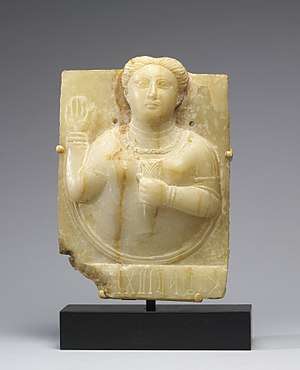Shams (goddess)

| Part of the myth series on |
| Religions of the ancient Near East |
|---|
| Pre-Islamic Arabian deities |
| Arabian deities of foreign origin |
|
Shams or Shamsum, also called Dhat-Ba' dhanum, is a sun goddess of Arabian mythology. She was the patron goddess of the Himyarite Kingdom . Her name meant shining, sun or brilliant. She was the South Arabian equivalent of the North Arabian sun goddess Nuha (deity).
Prior to Islam, religion on the Arabian Peninsula focused on local gods, with every tribe and kingdom having their particular protective deities. However, there were also gods common for all Arabs, and the trinity of gods representing the Sun, the Moon and the planet Venus seem to have been worshiped throughout Arabia, though their names, gender and worship differed between regions. Thus, Nuha was the name of the sun goddess in Northern Arabia, while the name of the sun goddess in Southern Arabia was Shams.
As Nuha, Shams was also worshiped in a trinity alongside the male gods of the Moon and Venus. In Saba', the sun goddess Shams was worshiped with the god of the planet Venus, Athtar, and Almaqah, the god of the Moon. In Hadhramaut, Shams was worshiped with Athtar and the moon god Syn.
Shams was described as the spouse of Athtar. She was given votive offerings in the shape of horses.
In Mesopotamia, Athtar was identified with the goddess Ishtar, and Shams with the sun god Shamash.
References
- Encyclopedia of World Religions, Encyclopaedia Britannica, Inc., 2006
- Yoel Natan, Moon-o-theism, Volume I of II
- Tenri Journal of Religion, Tenri University Press, 1975